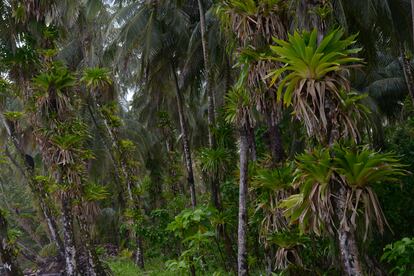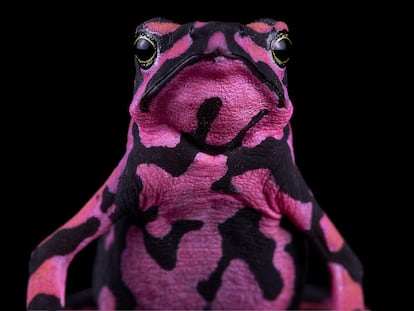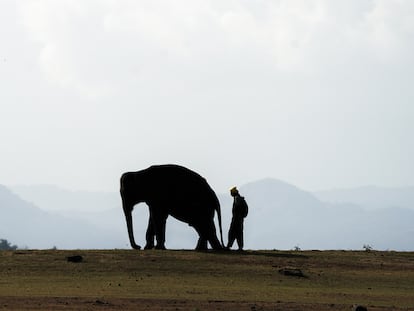Are plant species also becoming extinct?
Of all the species that were described in 2020, 77% are at high risk of extinction

The answer is yes. It is true that the best known studies of recent centuries refer mainly to the extinction of animals, what is known as the sixth extinction. I would add that these studies do not study all animals equally, but tend to focus more on vertebrates, specifically mammals and birds. What is well known in these groups is the relationship between the background extinction rate — the rate of species loss naturally occurring in the environment — and the extinction rate calculated for the last two centuries — which is what which has led to talk of a sixth great extinction.
To give an example, the background extinction rate in mammals is thought to be one extinction event per million species per year, which is how it is measured. In other words, one in every 1,000 species (0.001) would become extinct every century. And now, according to the lists of the International Union for Conservation of Nature (IUCN), it stands at 1.8 species per year, which means that about 180 species would become extinct in a hundred years. But this figure is also thought to underestimate the scale of the problem, as it refers to the extinction rate of the last five centuries. If we look only at the last 200 years, it is estimated that we are losing 390 species every century. This is why we talk about the sixth extinction, because the background extinction rate has multiplied by 40.
Nothing close to this level of precision exists in plants because their extinctions are less well documented by the IUCN. However, the extinctions that happen in specific ecosystems and specific countries are better known thanks to conservation reports. The Royal Botanic Gardens, Kew, in the United Kingdom, commonly known as Kew Gardens, produces the State of the World’s Plants and Fungi report every year. The last report was the most devastating, as it found a correlation between the year a plant species was described and its level of threat on the IUCN list. The more recently a plant was described, the greater its risk. For example, 77% of the species that were described in 2020 (three out of every four species) are under a high level of threat. Furthermore, it is estimated that a significant percentage of plant species preserved by a single specimen in herbaria or that are yet to be described have already become extinct.
The total number of described species represents just over 10% of the total number of species estimated to exist. We know of 1.9 million species, and it is estimated that around 8.7 million actually exist. The high threat of extinction facing plants suggests that of that 90% undiscovered species, it is very likely that a minimum of 77% is already endangered.
The speed at which plants are becoming extinct is very serious. Plants are the “building blocks” of ecosystems, they are the primary producers, and are, therefore, at the base of the trophic pyramid of an ecosystem. In ecosystems where plants are the dominant species, such as palm trees in tropical forests or grasses in grasslands, their disappearance would lead to the collapse of these ecosystems. In Africa, for example, deforestation and climate change are destroying ecosystems: it is estimated that 45% of species on the continent will become extinct by 2085, and up to 97% will see their range reduced.
At the Royal Botanical Garden (CSIC) in Spain, we are working on a project involving the Euphorbiaceae family, which includes the poinsettia and is especially rich in tropical forests around the world. Curiously, in Africa, although there are many genera of Euphorbiaceae, many of them have very few species — only one or two. By studying the evolution of these genera with DNA sequences, we have seen that they originated millions of years ago, when the continent had a more humid climate. We think that they were more diverse in the past, but were decimated by climate change, agriculture and deforestation. The complete extinction of these genera would mean the disappearance of unique evolutionary lines. Their unique morphological, physiological and genetic traits would also be lost to science. And I think this is confirmation of the bleak picture painted by the Kew Gardens report.
Isabel Sanmartín is a scientific researcher and vice director of Research and Documentation at the Royal Botanical Garden (CSIC)
Sign up for our weekly newsletter to get more English-language news coverage from EL PAÍS USA Edition
Tu suscripción se está usando en otro dispositivo
¿Quieres añadir otro usuario a tu suscripción?
Si continúas leyendo en este dispositivo, no se podrá leer en el otro.
FlechaTu suscripción se está usando en otro dispositivo y solo puedes acceder a EL PAÍS desde un dispositivo a la vez.
Si quieres compartir tu cuenta, cambia tu suscripción a la modalidad Premium, así podrás añadir otro usuario. Cada uno accederá con su propia cuenta de email, lo que os permitirá personalizar vuestra experiencia en EL PAÍS.
¿Tienes una suscripción de empresa? Accede aquí para contratar más cuentas.
En el caso de no saber quién está usando tu cuenta, te recomendamos cambiar tu contraseña aquí.
Si decides continuar compartiendo tu cuenta, este mensaje se mostrará en tu dispositivo y en el de la otra persona que está usando tu cuenta de forma indefinida, afectando a tu experiencia de lectura. Puedes consultar aquí los términos y condiciones de la suscripción digital.
More information
Últimas noticias
Most viewed
- Why we lost the habit of sleeping in two segments and how that changed our sense of time
- Charles Dubouloz, mountaineering star, retires at 36 with a farewell tour inspired by Walter Bonatti
- Venezuela faces its most tense Christmas yet
- CBS in crisis after pulling a report on Trump’s deportations to El Salvador (which later leaked online)
- Bukele clan fumes over investigation exposing their new wealth










































